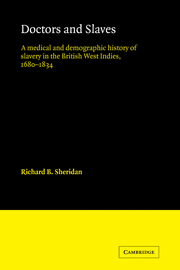 Doctors and Slaves
Doctors and Slaves Book contents
- Frontmatter
- Contents
- List of tables and figures
- Preface
- Acknowledgment
- 1 The disease environments and epidemiology
- 2 The medical profession
- 3 African and Afro-West Indian medicine
- 4 The Guinea surgeons
- 5 Slaves and plantations
- 6 Labor, diet, and punishment
- 7 Morbidity and mortality
- 8 The problem of reproduction
- 9 Smallpox and slavery
- 10 Slave hospitals
- 11 Plantation medical practice
- 12 Slavery and medicine
- Notes
- Bibliography
- Index
4 - The Guinea surgeons
Published online by Cambridge University Press: 04 August 2010
- Frontmatter
- Contents
- List of tables and figures
- Preface
- Acknowledgment
- 1 The disease environments and epidemiology
- 2 The medical profession
- 3 African and Afro-West Indian medicine
- 4 The Guinea surgeons
- 5 Slaves and plantations
- 6 Labor, diet, and punishment
- 7 Morbidity and mortality
- 8 The problem of reproduction
- 9 Smallpox and slavery
- 10 Slave hospitals
- 11 Plantation medical practice
- 12 Slavery and medicine
- Notes
- Bibliography
- Index
Summary
A young man, who has no immediate prospect of settling in his profession, is often lured by fair promises to become a surgeon of a Guinea ship; but ere long the bright prospect vanishes, and he finds that he has been cruelly deceived, and deplores, when too late, his degrading situation. If he possesses sensibility, his feelings are constantly on the rack; if his constitution be weak, his health is ruined, and he narrowly escapes with life. His attention to the poor creatures under his care must be unremitted.
Thomas Winterbottom, M.D., 1803This chapter focuses attention on the Guinea surgeons who treated sick slaves on British vessels engaged in the Atlantic slave trade. Early sections of the chapter are concerned with economic and demographic aspects of the slave trade and slavery, the dimensions of the trade, and West Africa's involvement in it. Questions are raised about the Guinea surgeons, their professional credentials, motivation, and especially the medical services they supplied to slaves. Later sections deal with mortality on the Middle Passage and efforts to reform the medical and other aspects of the trade.
“To buy or to breed”
The failure to produce a self-sustaining slave population was the most striking demographic peculiarity of the slave plantation societies of the Caribbean and other South Atlantic regions.
- Type
- Chapter
- Information
- Doctors and SlavesA Medical and Demographic History of Slavery in the British West Indies, 1680–1834, pp. 98 - 126Publisher: Cambridge University PressPrint publication year: 1985
